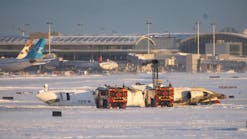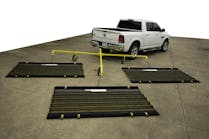Boeing’s new 777X aircraft will have one of the largest wingspans of any commercial airliners in the world – even wider than the 747. The 777X’s wingspan measures over 235 feet, designed to help the aircraft hold more passengers, fly more efficiently and bring fuel savings to airlines.
Because its composite wings will be so long, the new 777X would not be able to use the gates at most existing airports. To solve that problem, Boeing engineers created a unique wing-fold mechanism, a first for a civilian airliner. On the ground, the outer 12 feet of each wing will fold up vertically.
Boeing will test its new airliner at King County International Airport-Boeing Field south of Seattle, Washington. RS&H worked with the airport to create an operational plan for how the 777X can move around the airfield.
“We had to be creative with how we move the aircraft based on the current layout of the airfield,” said RS&H Lead Planner Steven Derengowski. “We had to take an unconventional approach to not only meet FAA requirements but also maintain airfield efficiencies.”
“The resulting plan is one that makes way for the 777X and also helps the current operations at King County International Airport,” said airport Properties and Business Development Administrator Matthew Sykora.
“Now we have a game plan that we can use time and time again,” Sykora said. “We have backup scenarios and we know every square inch of the airport and what can fit there. It’s a very thorough plan.”
Time and Space Constraints
King County International Airport-Boeing Field is one of the busiest non-hub airports in the U.S. Designed to FAA Group IV standards, the airport averages 200,000 takeoffs and landings each year and supports $3.5 billion in local business, serving small commercial passenger airlines, cargo carriers, private aircraft owners, helicopters, corporate jets and other aircraft. Boeing is the airport’s biggest tenant, which conducts delivery and maintenance on their fleet of 737 aircraft.
Creating an operational plan for a new wide-body jet – especially one meant for FAA Group V airports and not Group IV airports, like Boeing Field – would usually take several months to complete. But RS&H and the King County Airport only had a couple of months to develop solutions.
Not only were planners facing a time crunch, but the airfield presented its own challenges for the wide aircraft. After surveying the physical conditions of the pavement and performing core samples, the potential operating ranges turned out to be even tighter than anticipated.
“Knowing that we couldn’t make large capital improvements, we had to squeeze every square inch of pavement to get the aircraft from point A to point B,” Derengowski said. “After looking at the physical conditions of pavement, plus the width and strength, we could identify potential operating solutions to move around objects while trying to maintain the same level of service.”
Working Together to Find a Better Way
To find the best solution, RS&H planners met with every stakeholder involved or affected by the project, ranging from air traffic controllers and FAA planners, to engineers, airport staff and even Boeing 777X engineers and test pilots. The interviews allowed the team to gain technical aspects of the aircraft and of the airfield that were needed to prepare viable concepts.
“Planning in a bubble is not effective,” Derengowski. “We needed to get out front with every stakeholder and learn what their key issues were.”
Leaning on their learnings and a bit of creativity, RS&H Project Manager Steve Domino and the team built several operational scenarios based on what the aircraft would be doing. For arrivals, the planners learned that the Boeing 777X could stop short of the end of the runway and safely exit onto a taxiway that only required to make two 90-degree turns instead of turning around on the runway itself.
“By utilizing exits we don’t usually use, the plan made it easier for aircraft to enter and exit the runway,” Sykora said. “It gives us a ton of flexibility on how to maneuver the plane, and it gives us a plan on how to handle other large aircraft that come to our airport.”
Having the aircraft exit the runway one taxiway shorter not only cut airfield occupancy time by 90 seconds, but it also resolved a potential issue with the jet’s powerful twin engines blasting the nearby parking lot and buildings.
“In our meetings with the stakeholders at the airport, we’d present our recommendations and then listen to them to see how we could make them even better,” Derengowski said. “We wanted to make sure we captured what we heard from everyone to come up with the best solution for King County.
“We ultimately had buy-in on the plan from everyone and I would credit that to all of the communication we had. I believe what we learned could be used at similar airports across the country.”
The first Boeing 777X is set to arrive in King County later this year. Derengowski, Domino and the rest of the RS&H team hope to be on site to see the first test flight. The airport will be ready for its arrival.
“Everyone knows the plan,” Sykora said. “We’re ready for the 777X to land.”
Joe VanHoose serves as the public relations lead for RS&H, a national engineering and architecture firm that specializes in the planning and design of airports and airfields across the U.S. He is based in Jacksonville, Florida, and can be reached at [email protected].







